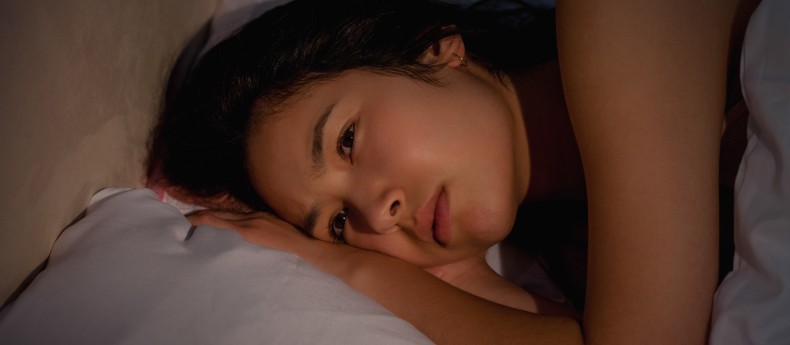
Insomnia
The pressures and demands of everyday life can lead to accelerated patterns of thoughts that may be difficult to control. Sometimes, at night, our brain struggles to slow down our thought processes or even switch our minds off for sleep. This may result in insomnia. More than 35% of adults are affected by insomnia, and about half of them are experiencing serious problems because of it.
We call it insomnia when all three of the following criteria are present:
- If the sleep is non-restorative or poor in quality due to difficulty falling asleep, maintaining sleep, or waking up too early.
- The sleep difficulty occurs despite adequate opportunity for sleep.
- Your daytime activities are affected by lack of sleep due to fatigue, poor attention spans, and mood swings. You may also experience drowsiness, lack of energy, an increase in accidents or errors, muscle tensions, headaches, and worries pertaining to sleep.
What to do?
1-The first step is implementing actions that may improve and help maintain good sleep. These techniques are known as sleep hygiene.
● Sleep until fully rested (usually 7 to 8 hours for adults) Avoid sleeping more than needed.
● Maintain a regular sleep schedule
● Try not to force sleep
● Avoid caffeinated beverages after lunch
● Avoid alcohol near bedtime
● Avoid smoking or other nicotine substances
● Adjust the bedroom environment as needed to decrease stimuli (light, noise, temperature)
● Avoid thinking in difficult issues at night
● Exercise regularly for at least 20 minutes, preferably more than four to five hours prior to bedtime
● Avoid daytime naps
2-Stimulus control — instead of associating their beds with the comforts of sleep, people with insomnia often face fears of not sleeping when going to bed. The association becomes stronger the longer one stays in bed. This perpetuates the difficulty of falling asleep.
Stimulus control therapy is a treatment with the purpose of countering this association. Patients should not go to bed until they are sleepy and should use the bed primarily for sleep (not for reading, watching television, eating, or worrying). If still awake after 20 minutes, patients should leave the bedroom and engage in a relaxing activity such as reading or listening to soothing music. During this period, patients should not engage in any stimulating activities like eating, working on a computer or electronic device and/or watching TV. Once they leave the bed, patients should not return until they are tired and ready to sleep. If they are still unable to fall asleep after 20 minutes the process should be repeated. An alarm clock should be set to awaken them at the same time every morning, including weekends.
3-Relaxation — Relaxation therapy may be implemented before each sleep period. There are two common techniques for relaxation therapy: progressive muscle relaxation and the relaxation response.
● Progressive relaxation is based on the theory that an individual can learn to relax one muscle group at a time until the entire body is relaxed. Beginning with muscles in the face, the muscles are contracted gently for one to two seconds and then relaxed. The same technique is used for other muscle groups, usually in the following descending sequence: jaw and neck, upper arms, lower arms, fingers, chest, abdomen, buttocks, thighs, calves, and feet. This cycle is repeated for approximately 45 minutes, if necessary.
● The relaxation response begins by lying or sitting comfortably. The eyes are closed allowing relaxation to spread throughout the body. After, a relaxed abdominal breathing pattern is established. Thoughts are directed away from everyday thoughts towards a neutral mental peaceful image.
4-Cognitive behavior therapy (CBT) is now considered the first-line treatment for chronic insomnia due to its superior long-term efficacy, lack of side effects, and patient preference. Several randomized, well-controlled efficacy trials have shown CBT to be superior to both pharmacotherapy and relaxation therapy. (3, 4, 5)
Finally, jet lag is a condition that happens when people fly across several time zones. The more time zones a person crosses, the more likely he or she is to get jet lag. Jet lag gets better as a person adjusts to the new time zone, but this can take several days.
Symptoms include:
● Sleep problems such as difficulty falling or staying asleep
● Feeling tired or sleepy during the day
● Having trouble thinking, concentrating, or doing normal activities
● Stomach problems such as constipation
● Feeling sick or having less energy than normal
There are a few things you can try:
● During the travel stay awake and eat meals according to the new time zone
● Exercise, but not right before bed
A supplement called “melatonin” can help with sleep problems from jet lag. Melatonin is a hormone that is naturally made by a gland in the brain. Taking extra melatonin can help your body adjust to a new time zone. The usual dose is 5 milligrams half an hour before you go to sleep at night.
Avoid drinking alcohol while you are taking melatonin.
1.Insomnia and its treatment. Prevalence and correlates. AU Mellinger GD, Balter MB, Uhlenhuth EH SO Arch Gen Psychiatry. 1985;42(3):225.
2. UpToDate Overview of insomnia, Michael H Bonnet, Donna L Arand,
3. J Clin Sleep Med. 2014;10:127-135
5. http://www.journalsleep.org/Articles/260209.pdf
6. UpToDate Jet lag. Andrew Herxheimer, Ruth Benca, April F Eichler,
Copyright United Family Healthcare 2018 All right reserved ICP 京ICP备13017554号-4




